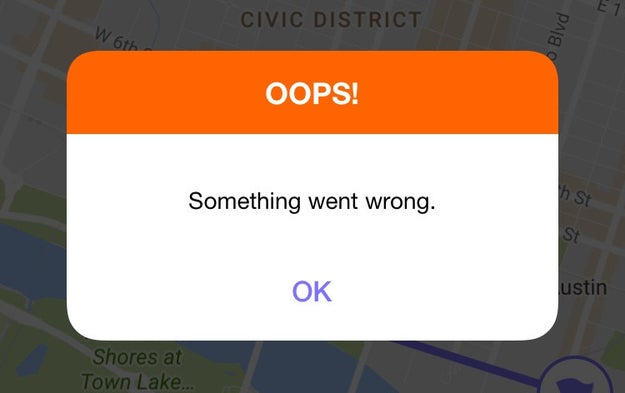
A screenshot of Fasten's app on Saturday.
William Alden / Via BuzzFeed News
Austin&039;s homegrown ride-hailing services, which sprung up after Uber and Lyft left the city in protest of a local rule, had hoped to ace the task of shuttling the global tech and media elite around the SXSW Conference and Festivals here this weekend.
But these apps — which claim Uber can be replaced, and that there&039;s no “secret sauce” behind its spectacular success — failed a major stress test during their moment in the spotlight last night.
With rain pouring down and crowds of festival attendees hopping from party to party, RideAustin and Fasten, two popular ride-hail apps in town, went totally dead for at least portions of the evening. Fasten, a small startup from Boston that paid to be the “official” ride-hail service of SXSW, experienced a 12-times increase in demand Saturday night that forced it offline for at least an hour. RideAustin, a nonprofit that&039;s especially popular among locals, was down for “several hours,” it said in a Facebook post, after its database was overloaded.
The local ride-hail apps still have a week to try to redeem themselves, but this weekend was supposed to be a triumph for them. RideAustin, Fasten, and others emerged in the Texas capital after Uber and Lyft exited last May, protesting a requirement that their drivers be fingerprinted for background checks. The local services portrayed the departure of the two behemoths as typical of the bullying capitalists from Silicon Valley.
But on Sunday, these homespun upstarts found themselves weathering a storm of customer rage that is all too familiar to Uber and Lyft.
“Spent an hour trying to find a ride,” tweeted Ryan Hoover, a well-known techie from San Francisco who founded Product Hunt. “Austin is broken w/o Uber or Lyft. Other ridesharing apps aren&039;t working and all the taxis are full.”
Others went on Twitter to post screenshots of the flatlining apps or of the breathtakingly high fares they had to pay when service was available. Fasten says it doesn&039;t use surge pricing — instead letting customers choose to pay more to attract drivers, with so-called “boost pricing” — but that claim rang hollow to riders who paid, in one example, more than $60 to go less than 5 miles on Saturday.
Fasten and RideAustin both made public apologies, saying the outages wouldn&039;t happen again. The CEO of Fasten, Kirill Evdakov, told BuzzFeed News that the higher prices, determined by algorithm, are necessary to attract drivers during busy times. (Fasten takes only 99 cents from each fare, even when prices reach the stratosphere — meaning drivers stand to make a serious killing if the app can stay online in the coming week.)
“We&039;re confident that it was a great idea to invest in support of SXSW,” Evdakov told BuzzFeed News on Sunday morning. Referring to the outage, he added, “We definitely don&039;t think it&039;s going to ruin SXSW in general. It&039;s just one hour out of 240 hours of the event.”
According to Austin locals interviewed by BuzzFeed News, the apps perform well in normal circumstances, and they&039;ve won devoted fans. The nonprofit RideAustin, which lets drivers keep the entirety of their fares for standard rides, invites customers to round their fares up to the nearest dollar and donate the balance to charity. Had the outages not happened, the SXSW festival might have provided a convincing argument against the effective duopoly enjoyed by Uber and Lyft.
“RideAustin now works as well as Uber. And the fact that it&039;s nonprofit and supports local charities I love,” said Rajiv Bala, an Austin-based venture capitalist at S3 Ventures.
“I like them better than Uber or Lyft,” said Chris Shonk, another Austin venture capitalist who is a general partner at ATX Seed Ventures. He said he especially appreciated how Fare, another local app, lets customers schedule a ride in advance.
Austin&039;s mayor, Steve Adler, told BuzzFeed News in an interview on Sunday that Uber can have issues, too. He recalled being unable to hail an Uber during the start of the Democratic National Convention in Philadelphia last year, and having to take a long bus ride back to his hotel.
He said he was rooting for Austin&039;s local ride-hail apps.
“I am hopeful and anxious for them, to see how they do tonight, and I hope that they do well,” Adler said. “This obviously was a test of capacity and capability that they hadn&039;t seen yet.”
The local apps had sought to make the most of the SXSW spotlight with a marketing push. In promotional cards at hotels, and in stickers plastered above urinals, RideAustin advertised the “lowest rate per mile” and declared, “NO UBER, NO PROBLEM!” Near the Austin Convention Center, marketers working for Fare wore branded t-shirts and handed out water bottles.
At hotels, official signage included a code for attendees to get $5 off their first Fasten ride. A Fasten ad in the SXSW guidebook says, “Uber Left” — with “Left” styled to look like Lyft&039;s logo — “it&039;s alright.”

William Alden / Via BuzzFeed News
But on Saturday night, many partygoers downtown were forced to walk in the rain or try to hail a traditional cab — though it seemed at times that hardly any were available.
Leaving the Andreessen Horowitz party, and unable to get a car in the pouring rain, Chris Messina and his friends found a creative solution. Messina, a well-known tech figure who until recently was an executive at Uber, hopped in a taxi that turned out to be occupied. The passenger, sitting shotgun, graciously allowed the group to squeeze in the back. It became a carpool, or as Messina declared, a makeshift UberPool.
LINK: Post-Uber Austin Has A Chance To Rebuild Ride-Hail
LINK: In An Austin Without Uber, Drivers Are Left Wondering What’s Next
Quelle: <a href="Austin&039;s Uber Replacements Flunked An Important Test During SXSW“>BuzzFeed








